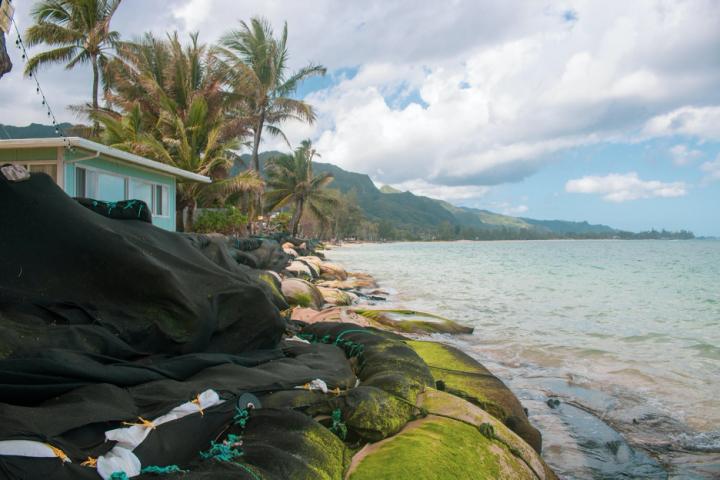
Credit: Kammie Tavares
The reactive and piecemeal approach historically used to manage beaches in Hawai’i has failed to protect them. If policies are not changed, as much as 40% of all beaches on O’ahu, Hawai’i could be lost before mid-century, according to a new study by researchers in the Coastal Geology Group at the University of Hawai’i (UH) at Mānoa School of Ocean and Earth Science and Technology (SOEST).
In an era of rising sea level, beaches need to migrate landward, otherwise they drown. Beach migration, also known as shoreline retreat, causes coastal erosion of private and public beachfront property. Shoreline hardening, the construction of seawalls or revetments, interrupts natural beach migration–causing waves to erode the sand, accelerating coastal erosion on neighboring properties, and dooming a beach to drown in place as the ocean continues to rise.
The team of scientists, led by graduate researcher in the SOEST Department of Earth Sciences Kammie Tavares, assessed the shoreline around O?ahu that would be most vulnerable to erosion under three scenarios of sea level rise–all estimated to occur before, and shortly after mid-century.
They identified the location and severity of risk of shoreline hardening and beach loss, and a potential timeline for the increase in erosion hazards. The most threatened properties fall into an “administrative erosion hazard zone,” an area likely to experience erosion hazards and qualify for the emergency permitting process to harden the shoreline.
“By assessing computer models of the beach migration caused by 9.8 inches (0.25 meters) of sea level rise, an amount with a high probability of occurring before mid-century, we found that emergency permit applications for shoreline hardening to protect beachfront property will substantially increase,” said Tavares.
According to co-author Dr. Tiffany Anderson, Assistant Researcher in the Department of Earth Sciences, “We determined that almost 30 percent of all present-day sandy shoreline on O’ahu is already hardened, with another 3.5 percent found to be so threatened that those areas qualify for an emergency permit today. Our modeling indicates that, as sea level rises about 10 inches (0.25 meters) by mid-century, an additional nearly eight percent of sandy shoreline will be at risk of hardening–meaning at that point, nearly 40% of Oahu’s sandy beaches could be lost in favor of hardened shorelines.”
“In another study published in 2018, we showed that accelerated erosion on neighboring properties, called flanking, usually leads to additional shoreline hardening, and condemnes entire beaches,” said co-author Dr. Chip Fletcher, Associate Dean and Professor in SOEST. “It is clear that management decisions made today, and during the careers of most of today’s natural resource managers, will be critical in determining if future generations will inherent a healthy shoreline, or one that has been ruined by seawalls, and other types of shoreline hardening.”
Coastal erosion is inevitable when sea level is rising and global mean sea level has been rising for decades and is accelerating. The Intergovernmental Panel on Climate Change has projected continued sea level rise for many centuries, even if greenhouse gas emissions are reduced or stopped altogether. However, economists are projecting that greenhouse gas emissions will likely continue into mid-century and we will see more years like 2019 when the use of fossil fuels rose faster than the use of renewable forms of energy.
“Despite these facts, we continue to see shoreline hardening as the preferred policy choice, largely because management agencies have failed to develop assisted transition plans for beachfront landowners who are caught in a tightening vice because of accelerating sea level rise,” said Fletcher. “In fact, directly to the contrary, beachfront lands continue to be sold to unwitting buyers with no appreciation for the expensive and frustrating situation they are entering into.”
“Because coastal zone management laws continue to allow hardship variances in this era of rising sea level, despite widespread knowledge that seawalls kill beaches under these conditions, the same legal system designed to protect public trust lands, is responsible for destroying them,” according to Fletcher. “Government agencies must develop creative and socially equitable programs to rescue beachfront owners and free the sandy ecosystem so that it can migrate landward as it must in an era of rising seas. It is urgent that options are developed soon for beachfront landowners and resource managers to avoid further destructive management decisions.”
“Beaches are critical ecosystems to native plants and animals, offer protection from storms, are an essential cultural setting, and attract tourists, who are important for Hawai’i’s current economy,” added Tavares. “This research shows that conversations on the future of our beaches and how we will care for them must happen now rather than later, if we are to protect our sandy beaches.”
###
Media Contact
Marcie Grabowski
[email protected]
Original Source
https:/
Related Journal Article
http://dx.




